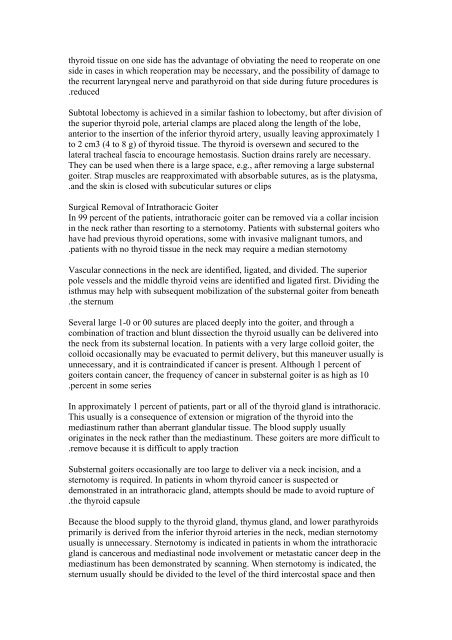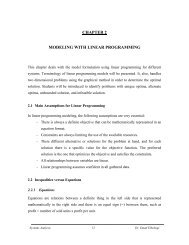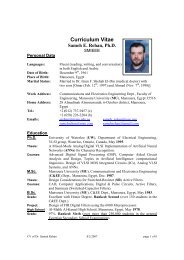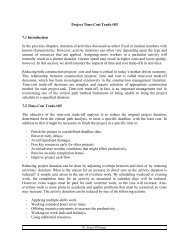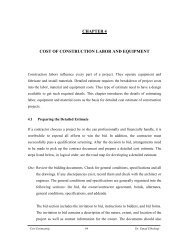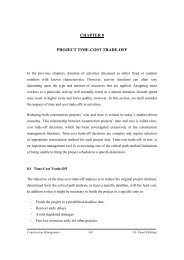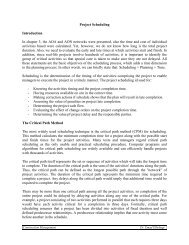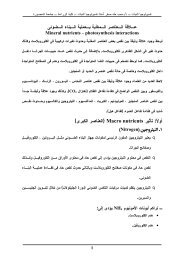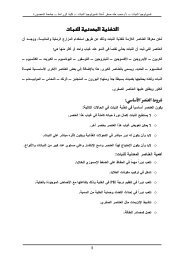Thyroid and Parathyroid
Thyroid and Parathyroid
Thyroid and Parathyroid
Create successful ePaper yourself
Turn your PDF publications into a flip-book with our unique Google optimized e-Paper software.
thyroid tissue on one side has the advantage of obviating the need to reoperate on one<br />
side in cases in which reoperation may be necessary, <strong>and</strong> the possibility of damage to<br />
the recurrent laryngeal nerve <strong>and</strong> parathyroid on that side during future procedures is<br />
. reduced<br />
Subtotal lobectomy is achieved in a similar fashion to lobectomy, but after division of<br />
the superior thyroid pole, arterial clamps are placed along the length of the lobe,<br />
anterior to the insertion of the inferior thyroid artery, usually leaving approximately 1<br />
to 2 cm3 (4 to 8 g) of thyroid tissue. The thyroid is oversewn <strong>and</strong> secured to the<br />
lateral tracheal fascia to encourage hemostasis. Suction drains rarely are necessary.<br />
They can be used when there is a large space, e.g., after removing a large substernal<br />
goiter. Strap muscles are reapproximated with absorbable sutures, as is the platysma,<br />
. <strong>and</strong> the skin is closed with subcuticular sutures or clips<br />
Surgical Removal of Intrathoracic Goiter<br />
In 99 percent of the patients, intrathoracic goiter can be removed via a collar incision<br />
in the neck rather than resorting to a sternotomy. Patients with substernal goiters who<br />
have had previous thyroid operations, some with invasive malignant tumors, <strong>and</strong><br />
. patients with no thyroid tissue in the neck may require a median sternotomy<br />
Vascular connections in the neck are identified, ligated, <strong>and</strong> divided. The superior<br />
pole vessels <strong>and</strong> the middle thyroid veins are identified <strong>and</strong> ligated first. Dividing the<br />
isthmus may help with subsequent mobilization of the substernal goiter from beneath<br />
. the sternum<br />
Several large 1-0 or 00 sutures are placed deeply into the goiter, <strong>and</strong> through a<br />
combination of traction <strong>and</strong> blunt dissection the thyroid usually can be delivered into<br />
the neck from its substernal location. In patients with a very large colloid goiter, the<br />
colloid occasionally may be evacuated to permit delivery, but this maneuver usually is<br />
unnecessary, <strong>and</strong> it is contraindicated if cancer is present. Although 1 percent of<br />
goiters contain cancer, the frequency of cancer in substernal goiter is as high as 10<br />
. percent in some series<br />
In approximately 1 percent of patients, part or all of the thyroid gl<strong>and</strong> is intrathoracic.<br />
This usually is a consequence of extension or migration of the thyroid into the<br />
mediastinum rather than aberrant gl<strong>and</strong>ular tissue. The blood supply usually<br />
originates in the neck rather than the mediastinum. These goiters are more difficult to<br />
. remove because it is difficult to apply traction<br />
Substernal goiters occasionally are too large to deliver via a neck incision, <strong>and</strong> a<br />
sternotomy is required. In patients in whom thyroid cancer is suspected or<br />
demonstrated in an intrathoracic gl<strong>and</strong>, attempts should be made to avoid rupture of<br />
. the thyroid capsule<br />
Because the blood supply to the thyroid gl<strong>and</strong>, thymus gl<strong>and</strong>, <strong>and</strong> lower parathyroids<br />
primarily is derived from the inferior thyroid arteries in the neck, median sternotomy<br />
usually is unnecessary. Sternotomy is indicated in patients in whom the intrathoracic<br />
gl<strong>and</strong> is cancerous <strong>and</strong> mediastinal node involvement or metastatic cancer deep in the<br />
mediastinum has been demonstrated by scanning. When sternotomy is indicated, the<br />
sternum usually should be divided to the level of the third intercostal space <strong>and</strong> then


